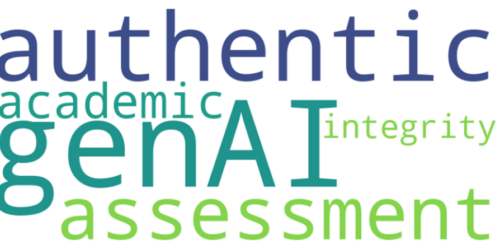
Designing and Implementing Socio-Culturally Responsive and Equitable Classroom Assessments
This post was co-authored by Dr. David Baidoo-Anu and Dr. Monsurat Raji, Assessment of Learning Consultants.
Given the increased diversities in our classrooms today, student assessment should recognize and value the unique perspectives and experiences of all students and help them demonstrate their learning in a more meaningful way. Therefore, instead of accommodating assessment to meet the specific needs of one particular student group, which can unintentionally exclude others, we best focus on creating assessments that are inclusive and accessible to every student (Nieminen, 2022; Tai, et al. 2022). It is therefore crucial to design and implement assessments that support a broad range of students and their diverse learning needs.
This follow-up Hub post to Understanding Socio-culturally Responsive Assessments discusses some strategies that may assist you in designing and implementing socio-culturally responsive and equitable assessment practices.
Key considerations in designing and implementing socio-culturally responsive and equitable student assessments.
Develop awareness of diversities in your class
Designing inclusive assessment begins with recognizing and valuing the diverse backgrounds, experiences, and abilities of student. Due to the changing nature of identities and the growing diversity in our societies, traditional ways of grouping and categorizing students are no longer sufficient to capture the complexity of today’s society (Baidoo-Anu et al, 2023). Therefore, we need to avoid assumptions and know our students. Assumptions can lead to biases and inequities in assessment practices. Building genuine understanding of your students and the experiences they bring to the learning space, and what challenges they may face is vital in designing assessments that are relevant, meaningful, and respectful of their diversity. For example, you can engage your students in a personal conversation. Take time to talk with your students individually. Ask about their interests, goals, and challenges. Also, create a safe space for students to easily approach you and share their learning preferences and challenges. Explicitly let students know they can reach out to you for questions, concerns, or guidance.
Pay critical attention to language use in your assessment tasks.
The language we use in our assessments can either include or exclude students. It’s important to use clear, inclusive, and culturally sensitive language to ensure all students can understand and respond effectively to assessment questions. For example, “football” in Canada means “soccer” to some students. Rather than asking questions on football, you could add soccer in parenthesis or add an image of the game. You may also discuss or socialize course-related languages with students during active learning activities in class before an assessment. Inclusive language avoids jargon and culturally specific references that may be unfamiliar to some students, thus preventing misunderstandings. To ensure that your language is more inclusive, you can conduct a language sensitivity review. This involves sharing a draft of your assessment with a diverse group of colleagues and others to identify any language or wording that might not be inclusive. After students finish the assessment task, consider conducting cognitive interviews with them. Inquire about any challenges or difficulties they encountered while completing the task. Additionally, seek their input on how to enhance the accessibility of the assessment. Below are some cognitive interview questions you might consider asking your students. You can adapt these questions to suit your specific course.
- Can you describe your thought process as you worked through the assessment task?
- Were there any specific parts of the task that you found particularly challenging?
- Did you encounter any difficulties understanding the instructions or requirements of the task?
- Were there any resources or supports that you felt were lacking during the assessment?
- Did you feel that you had enough time to complete the task adequately? Why or why not?
- Were there any distractions or external factors that affected your performance on the assessment?
- Can you suggest any changes or adjustments that could be made to the assessment task to make it more accessible for students like yourself?
- Did you feel that the assessment accurately reflected your understanding of the material? Why or why not?
- Overall, how do you feel about your experience with this assessment task?
Avoid assignment prompts that may marginalize students.
Assignment prompts should be crafted with care to ensure they do not marginalize any group of students. Topics that assume a certain cultural, socioeconomic, or personal experience can inadvertently alienate students who do not share those backgrounds. For instance, assignments that require students to write about family traditions or holidays can exclude those from diverse or non-traditional family structures. Or reflection assignments that require students to research winter sports and popular physical activities in Canada. The topic may lack relevance for many learners and may not connect with some students’ personal experiences and give them opportunities to learn about each other’s identities. To create inclusive prompts, consider a wide range of experiences and perspectives, and offer alternative options for students to choose from. Encouraging students to bring their unique perspectives into their assignments can make the learning experience more inclusive and engaging.
Use a range of assessment tasks in your course.
Provide students with multiple opportunities to demonstrate their learning. Incorporating varying assessment tasks such as essays, multiple-choice questions, projects, and peer assessments ensures that assessments address multiple dimensions of learning and skill application. Providing choice to students “levels the playing field” by ensuring that each student has the opportunity to demonstrate their learning in a way that best suits their strengths and preferences. This approach eliminates the need for making individual accommodations to students based on their needs. This balanced approach not only accommodates different strengths of students but also reduces the risk of any single assessment method disproportionately affecting some student’s overall performance.
Provide clear instructions and expectations.
Clear instructions and expectations are foundational elements of inclusive assessment practices. Sets clear and equitable criteria for assessment, ensuring all students understand how they will be evaluated. When providing assessment instructions, it’s crucial to be specific and break down tasks into manageable steps. You may want to use active voice to convey directives clearly. For example, instead of saying “The essay should be written with proper citations,” you could say, “Please write the essay using proper citations following the APA style guide.” This precision leaves no room for ambiguity and assists students in meeting the requirements accurately. Further, you can provide links to the Library’s support for students related to APA.
Socialize students with the grading tool.
Ensure that the grading criteria are clear and accessible to all students and discuss the grading criteria with the students. You may want to use the explanation session to also draw feedback on the grading tool from students. This way, you want to know the questions they have and to be able to clarify any misconceptions. You may want to explain how assessments will be conducted, what criteria you will use for evaluation, and how grades will be assigned to each assessment component. Transparency builds trust and helps students understand what is expected of them.
Summary
The figure (Routes to inclusive assessment) below provides a summary of key considerations to designing and implementing socio-culturally responsive and equitable classroom assessments.
Routes to inclusive assessment

References
Baidoo-Anu, D., Lei, L., Cisterna, D., & Song, Y. (2023). Cultural validity: Promoting cultural responsiveness in classroom assessment. Diaspora, Indigenous, and Minority Education, 1-22. https://www.tandfonline.com/doi/abs/10.1080/15595692.2023.2193883.
Swansea University, (2018). Inclusive assessment for student success. https://www.swansea.ac.uk/media/DIL-Inclusive-Assessment-InfoSheet-v-3.1.pdf.
Tai, J. H. M., Dollinger, M., Ajjawi, R., Jorre de St Jorre, T., Krattli, S., McCarthy, D., & Prezioso, D. (2023). Designing assessment for inclusion: An exploration of diverse students’ assessment experiences. Assessment & Evaluation in Higher Education, 48(3), 403-417.
Tai, J., Ajjawi, R., Bearman, M., Boud, D., Dawson, P., & Jorre de St Jorre, T. (2023). Assessment forinclusion: Rethinking contemporary strategies in assessment design. Higher Education Research & Development, 42(2), 483-497.
The Alberta Teachers’ Association (2020). Student Assessment in an Inclusive Classroom. https://otl.uoguelph.ca/system/files/Principles%20of%20Effective%20and%20Inclusive%20Assessment.pdf.





